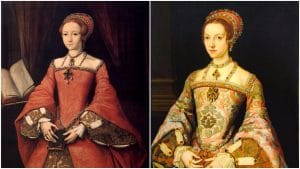 On this day in history, 31st July 1544, ten-year-old Elizabeth, daughter of Henry VIII and his second wife, Anne Boleyn, wrote a letter to her stepmother, Catherine Parr, Henry VIII’s sixth and final wife. It’s the earliest surviving letter written by the future Queen Elizabeth I and Mary Anne Everett Green, editor of Letters of Royal and Illustrious Ladies of Great Britain, in which the letter is translated and transcribed, explains:
On this day in history, 31st July 1544, ten-year-old Elizabeth, daughter of Henry VIII and his second wife, Anne Boleyn, wrote a letter to her stepmother, Catherine Parr, Henry VIII’s sixth and final wife. It’s the earliest surviving letter written by the future Queen Elizabeth I and Mary Anne Everett Green, editor of Letters of Royal and Illustrious Ladies of Great Britain, in which the letter is translated and transcribed, explains:
“This epistle, which is in elegant Italian, was written to Queen Catherine Parr, as regent, in 1544, during the absence of Henry VIII. The cause of the long absence of the princess from the court of her step-mother, of which she complains, has not transpired.”
Here is Elizabeth’s letter in English:
“Inimical fortune, envious of all good and ever revolving human affairs, has deprived me for a whole year of your most illustrious presence, and, not thus content, has yet again, robbed me of the same good; which thing would be intolerable to me, did I not; hope to enjoy it very soon. And in this my exile, I well know that the clemency of your highness has had as much care and solicitude for my health as the king’s majesty himself. By which thing I am not only bound to serve you, but also to revere you with filial love, since I understand that your most illustrious highness has not forgotten me every time you have written to the king’s majesty, which, indeed, it was my duty to have requested from you. For heretofore I have not dared to write to him. Wherefore I now humbly pray your most excellent highness that when you write to his majesty, you will condescend to recommend me to him, praying ever for his sweet benediction, and similarly. entreating our Lord God to send him best success and the obtaining of victory over his enemies, so that your highness and I may, as soon as possible, rejoice together with him on his happy return. No less pray I God, that he would preserve your most illustrious highness; to whose grace, humbly kissing, your hands, I offer and recommend myself.
From St. James’s this 31st of July.
Your most obedient daughter, and most
faithful, servant,
ELIZABETH.”
Why would a ten-year-old write to her stepmother in Italian?
Well, David Starkey, in his book Elizabeth explains: “Like most of the letters of royal children, it is only secondarily a vehicle of communication. Its primary purpose, instead, was to show off the latest of Elizabeth’s scholarly attainments.” Starkey goes on to point out that Queen Catherine would have needed the help of a translator to understand what he describes as “elaborate, courtly Italian.” I wish I could have written about “inimical fortune” in Italian at the age of ten!
By the way, Elizabeth was not in any type of “exile” at this point. She had been at court and Starkey points out that she had dined with her father, Mary and Edward just a month earlier, but she had missed seeing Catherine.
Notes and Sources
Picture: Portrait of a young Elizabeth I by William Scots; portrait of Catherine Parr, the Melton Constable Portrait.
- Green, Mary Anne Everett (1846) Letters of royal and illustrious ladies of Great Britain, from the commencement of the twelfth century to the close of the reign of Queen Mary, Volume 3, Ho. Colburn, London, p. 176-177. The letter had been translated and transcribed from the “Cotton MS., 0TH0., c. X. FOL. 231” and was described as “Holograph, Italian, burnt.” https://archive.org/details/lettersroyaland06greegoog
- Starkey, David (2001) Elizabeth: Apprenticeship, Vintage, p. 35-36.